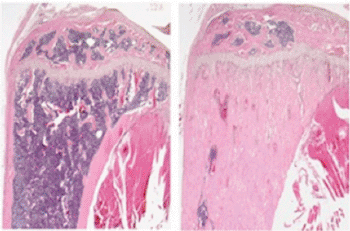Generation of New Bone Depends on WNT Stimulation of the mTORC1 Pathway
By LabMedica International staff writers
Posted on 18 Feb 2014
The WNT signaling protein WNT7B potently enhances formation of new bone through activation of mTORC1 (mammalian target of rapamycin) in a mouse osteoporosis model.Posted on 18 Feb 2014
Previous studies have implicated WNT signaling in both embryonic and postnatal bone formation. However, the pertinent WNT ligands and their downstream signaling mechanisms are not well understood.

Image: As seen through a microscope, the leg bone of a normal mouse (left) makes considerably less new bone than a mouse that produces high levels of a signaling protein, WNT7B, that stimulates new bone growth (shown in pink on the right). The protein could become a target for new drugs to treat osteoporosis and other conditions related to bone loss (Photo courtesy of Washington University School of Medicine).
Investigators at the Washington University School of Medicine (St. Louis, MO, USA) used several lines of genetically engineered mice to examine the role of WNT signaling in bone formation.
The WNT gene family consists of structurally related genes that encode secreted signaling proteins. These proteins have been implicated in oncogenesis and in several developmental processes, including regulation of cell fate and patterning during embryogenesis. The WNT pathway involves a large number of proteins that can regulate the production of WNT signaling molecules, their interactions with receptors on target cells, and the physiological responses of target cells that result from the exposure of cells to the extracellular WNT ligands. Although the presence and strength of any given effect depends on the WNT ligand, cell type, and organism, some components of the signaling pathway are remarkably conserved in a wide variety of organisms.
Results published in the January 30, 2014, online edition of the journal PLOS Genetics revealed that WNT7B protein increased bone mass by stimulating formation of bone-building osteoblast cells while having no effect on the activity of bone-degrading osteoclasts. At the molecular level, it was seen that WNT7B exerted its effects through activation of the mTORC1 pathway. MTORC1 is a serine/threonine protein kinase of the phosphatidylinositol 3-kinase (PI3K) protein family that regulates cell growth, proliferation, motility, survival, protein synthesis, and transcription.
Genetic disruption of mTORC1 signaling prevented the WNT7B-induced formation of high-bone-mass phenotype mice.
“We have been looking for new ways to stimulate bone formation,” said senior author Dr. Fanxin Long, professor of medicine and developmental biology at the Washington University School of Medicine. “The tools we already have are very good at slowing the breakdown of bone, but we need better ways to stimulate new bone growth. By analyzing that information, mTOR can determine whether a cell should go into a mode to make lots of stuff, like proteins or, in this case, new bone. Bone formation is an energetically expensive process, so it makes sense that some regulator would tell a cell whether there is sufficient energy and material to manufacture new bone. It is still early, but our finding seems to point out that activating the mTOR pathway may be a good way to stimulate bone growth. This is a new twist because much of the current focus in mTOR-related drug development has been on compounds that inhibit the pathway to shut down cancer cells.”
Patients, such as organ transplant recipients, who have been treated with immunosuppressive drugs that inhibit the mTOR pathway often present with bone problems. “Many develop bone problems within a few months of receiving transplants because of the heavy doses of immunosuppressors they receive,” said Dr. Long. “Scientists have not looked carefully at how drugs used to prevent organ rejection can have a detrimental effect on bone, but our study would suggest that if those drugs inhibit mTOR, they could disrupt bone formation.”
Related Links:
Washington University School of Medicine










 (3) (1).png)


